

RAM showcases the work of pioneer artists who have addressed the relationship between art and electronic technology, light, graphics, robots, and virtual reality dating back to the 1960's.

RAM | Rethinking Art and Machine showcases the work of pioneer artists who address the relationship between art and electronic technology, light, graphics, robots, and virtual reality dating back to the 1960's.
The artists include Jim Campbell, George Legrady, Manfred Mohr, Alan Rath, David Rokeby, Daniel Rozin and Peter Vogel. These innovators have broken down the traditional boundaries that have existed between the artistic and technological disciplines. RAM the exhibit will survey the work and ideas of these artists and the understanding of their aesthetics and socio-cultural aspirations. Within each one of these unique artist areas the audience will learn how each artist integrates their personal life experiences through human-computer interactions and the humanization of machines.
RAM is an interactive exhibit. A wide body of work will be presented from each artist, allowing the audience to understand the impact of evolving technology as it relates directly to the artist and their own personal vision and message.
Marla Wasser is the President of Pursuits, a consulting company specializing in art advisory.
Previous to RAM, Marla created the original exhibition The Art, Inspiration and Appropriation of Andy Warhol for The Children’s Museum of Waterloo Region, in partnership with the Andy Warhol Museum in Pittsburgh and the Andy Warhol Foundation, New York. This exhibit was the first time Warhol and appropriations of his work were shown side by side. You can learn more about this show at http://pursuitsinc.com/Warhol
Pursuits Inc.’s curatorial focus has been the creation, from start to finish, of exhibitions that are both creatively significant and thought provoking, with education as a priority.
RAM is an interactive exhibit. A wide body of work will be presented from each artist, allowing the audience to understand the impact of evolving technology as it relates directly to the artist and their own personal vision and message.
Marla Wasser is the President of Pursuits, a consulting company specializing in art advisory. She has created RAM as an original exhibition for THEMUSEUM. This is the second collaboration between Marla and THEMUSEUM; the first being the highly acclaimed Andy Warhol exhibit that debuted last year. Marla's vast experience in the art world and her intense desire to bring the finest art to the widest possible audience gel seamlessly with THEMUSEUM's mission of presenting ideas that transcend objects.


Jim Campbell | Exploded View (Birds), 2010
1152 LED, custom electronics, wire steel
44.5 x 62.75 x 36.75 inches
Courtesy of the artist
Manfred Mohr | P-1011/F subset.motion, 2005-2006
flat screen, computer, custom software
dimensions variable
Courtesy of bitforms gallery nyc
Manfred Mohr | P-777w, 2004
Handmade PC (blue), NEC LCD 20.1"
Dimensions Variable
Courtesy of bitforms gallery nyc
David Rokeby | Dark Matter, 2010
Daniel Rozin | X by Y, 2010
44 wooden slats, motors, control electronics, optional video camera, custom software, microcontroller
56 x 56 x 4" / 142 x 142 x 10 cm
Edition 1 of 8, 1 AP | Courtesy of bitforms gallery nyc
Daniel Rozin | Trash Mirror No. 3, 2011
500 discarded objects, motors, video camera, wood, control electronics, custom software
76 x 76 x 6" / 193 x 193 x 15.2 cm
Courtesy of bitforms gallery nyc
Daniel Rozin | Darwinian Straw Mirror, 2010
computer, custom software, video camera, screen display or projector
dimensions variable
Edition 1 of 6 | Courtesy of bitforms gallery nyc
Peter Vogel | Circular Structure, 1979
speaker, photo cell, circuits, iron wire
27 x 17.75 x 7" / 69 x 45 x 18 cm
110 volts | Courtesy of bitforms gallery nyc

These innovators have broken down the traditional boundaries that have existed between the artistic and technological disciplines. RAM the exhibit will survey the work and ideas of these artists and the understanding of its aesthetics and socio-cultural aspirations. Within each one of these unique artist areas the audience will learn how each artist integrates their personal life experiences through human-computer interactions and the humanization of machines.

Click an artist to view their bio.

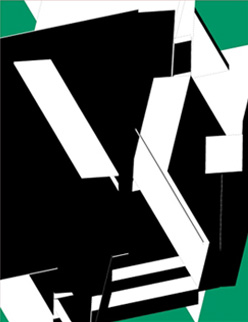
Born in 1938 in Pforzheim Germany, Manfred Mohr is considered a pioneer of computer generated art. After discovering Prof. Max Bense's information aesthetics in the early 1960's, Mohr's artistic thinking was radically changed. Within a few years, his art transformed from abstract expressionism to computer generated algorithmic geometry. Encouraged by the computer music composer Pierre Barbaud whom he met in 1967, Mohr programmed his first computer drawings in 1969 using the Fortran programming language to write algorithms as a vehicle of formal procision.
In 1971, he had an exhibition at the Musee d'Art Moderne, Paris, which is considered to be the first solo show in a museum of works entirely calculated and drawn with a computer.
The rules of geometry, logic and mathematics are fundamental to the custom-authored algorithms that generate Mohr's artwork. His pieces are based on the logical structure of cubes and hypercubes.
Mohr's work is collected by the Centre Pompidou, Paris, as well as major Museums across Europe. He has exhibited at the Museum of Modern Art, New York, Los Angeles, and many others across North America. Since 1981, Mohr lives and works in New York.

Jim Campbell was born in 1956 in Chicago, Illinois. He received degrees in both electrical engineering and mathematics from the Massachusetts Institute of Technology in Cambridge, Massachusetts in 1978, and is currently living and working in San Francisco, California. As an engineer, Campbell holds more than a dozen patents in the field of image processing and HDTV technologies.
Originally a filmmaker, Campbell transitioned from film making to interactive video installations in the mid 1980's. His custom electronic sculptures and installations have made him a leading figure in the use of computer technology as an art form.
Campbell combines more traditional media, such as video with his own inventions. He uses custom-made electronics to explore the relationship between information and knowledge, examining how we translate and understand the data that we receive. His work is deeply immersed in new technologies of software, electronic components, programming languages, the physics of waveform and light, transmission and frequency. Although his works are technologically complicated, the concepts such as memory and intimate familial relationships are a constant theme and humanize the machines for the audience to participate with their own very personal interpretations.
His electronic artworks have been exhibited and collected in Museums throughout the United States and Europe, including the San Francisco Museum of Modern Art, The Museum of Modern Art, New York. The Whitney Museum of American Art, New York, and the Metropolitan Museum of Art, New York.
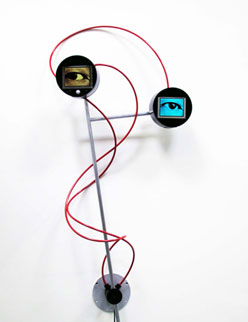
Born in 1959, Alan Rath received his Bachelor of Science in Electrical Engineering in 1982 from the Massachusetts Institute of Technology.
Rath brings a unique perspective to his art making: a knowledge of historically important sculpture, a deep understanding of technology, creative experience and the human condition. He is committed to experimentation and the usage of new materials in art making that create sculptures that remain on the cutting edge of both scientific and artistic innovation. Motion sensors in his sculptures allow for interaction between art and audience, countering technological alienation by breaking down the barriers between human and machine while simultaneously questioning the positivity of society-wide over-familiarity and identification with technology.
Rath is a comprehensive designer, making interdisciplinary art that incorporates his studies of human behavior, sociology, physics, chemistry, art history, artificial intelligence, and a fair dose of humor.
He has had several solo museum exhibitions and group shows. Highlights include: Walker Arts Center, Minneapolis, Whitney Museum, New York, San Francisco Museum of Modern Art and many more world wide.
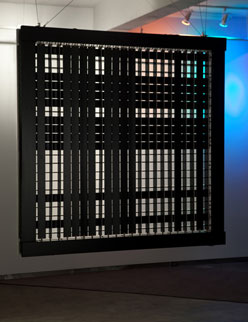
Daniel Rozin is an artist, educator and developer, working in the area of interactive digital art. As an interactive artist Rozin creates installations and sculptures that have the unique ability to change and respond to the presence and point of view of the viewer. In many cases the viewer becomes the contents of the piece and in others the viewer is invited to take an active role in the creation of the piece. Even though computers are often used in Rozin's work, they are seldom visible.
As an educator, Rozin is Associate Art Professor at ITP, Tisch School Of The Arts, NYU where he teaches such classes as: "The World- Pixel by Pixel", "Project Development Studio" and "Toy Design Workshop".
Born in Jerusalem and trained as an industrial designer Rozin lives and works in New York. His work has been exhibited widely with solo exhibitions in the US and internationally and featured in publications such as The New York Times, Wired, ID, Spectrum and Leonardo. His work has earned him numerous awards including Prix Ars Electronica, ID Design Review and the Chrysler Design Award.
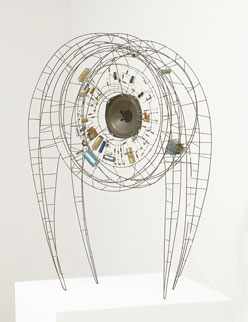
Born in 1937, Peter Vogel is a pioneer in the field of interactive electronic sculpture. Living and working in Freiburg, Germany, he was formally trained in Physics, but has explored technology's intersection with dance, musical composition and visual art since the late 1960s. Vogel's minimalist musical compositions share territory with that of Detroit techno, Phillip Glass and Steve Reich, where variations and increasing complexity result from the addition or negation of repetitive phrases.
Vogel's interest lies in both interactive and musical structures. His is an active art that encourages viewers to discover communication structures through repeated interaction. Red, green, and blue light-emitting diodes, wire, photo cells, bare speakers, resistors and capacitors are the raw materials with which Peter Vogel crafts audiovisual constellations. The interactive sensitivity of Vogel's constructions utilizes photocells and microphones that react to spectators, creating an experience of seeing and hearing unique improvisations triggered by light and shadow. Merging form and function, the delicate electronic circuits in Vogel's artworks are elegantly arranged. Electronic logic of each sculpture is determined through circuitry, but the reactions may sometimes feel random because of their sensitive dependence upon the time patterns of input.
His work has been the subject of retrospectives in museums in Germany as well many exhibitions throughout the world.
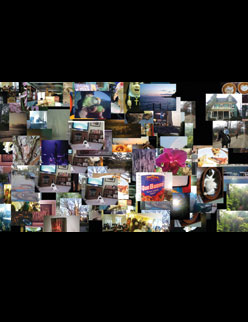
George Legrady is one of the first generation of artists in the 1980's to integrate computer processes into his artistic work, producing pioneering prizewinning projects that explore the relationship of digitality and cultural narrative. Legrady's contribution to the digital media field since the early stages of its formation into a discipline in the early 1990's has been in intersecting cultural content with data processing as a means of creating new forms of aesthetic representations and socio-cultural narrative experiences.
His best known recent works include "Making Visible the Invisible" a ten year data visualization at the Seattle Central Library (2005-2014) that maps the reading interests of the community; the internationally traveling "Pockets Full of Memories" (2001-2008) commissioned by the Centre Pompidou, and his "We Are Stardust", commissioned by the NASA Spitzer Science Center at Caltech that maps the observations of the Spitzer satellite. This project was featured in the "Observe" exhibition at the art Center College of Design, and at the Vancouver Olympics in 2010. For this exhibition Legrady is presenting, in collaboration with engineer Angus Forbes, "Cell Tango" (2007-2009) an interactive work where the public creates a visual archive of cellphone images.
His digital interactive installations have been exhibited nationally and internationally most recently at Poznan Biennale (2010), Lawrence Hall of Science, Berkeley (2010), Wellesley College, Wellesley (2009), East Michigan University, Ypsilanti (2008).
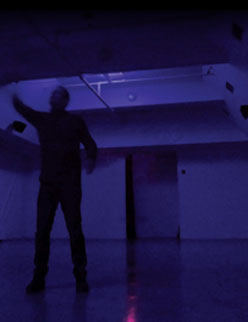
David Rokeby is one of the world's pioneering interactive sound and non-linear installation based in Toronto, Rokeby studied experimental art at the Ontario College of Art from 1979 to1984 and has been creating interactive installations since 1982. He has focused on interactive piecesthat directly engage the human body or involve artificial perception systems. Rokeby's best-knownseries of installations, Very Nervous System (1986 to present), was first displayed at the VeniceBiennale in 1986 and has since been consistently shown around the world. Rokeby won the firstPetro-Canada Award for Media Arts in 1988 and the Prix Ars Electronica Award of Distinction forInteractive Art (Austria) in 1991, 1997 with Paul Garrin and again in 2002. This same year, Rokebywon the Governor's General Visual and Media Arts Award. His current work, 'Through The VanishingPoint ' (2010) in collaboration with sound artist and media sciences researcher Lewis Kaye wascommissioned by the Scotiabank Contact Photography Festival and the McLuhan Program in Cultureand Technology, Coach House Institute, Faculty of Information, University of Toronto. This site specificartwork, using McLuhan's archive of teaching and educational works, will be adapted to and installedin the Marshall McLuhan Salon of the Embassy of Canada in Berlin during the summer of 2011.